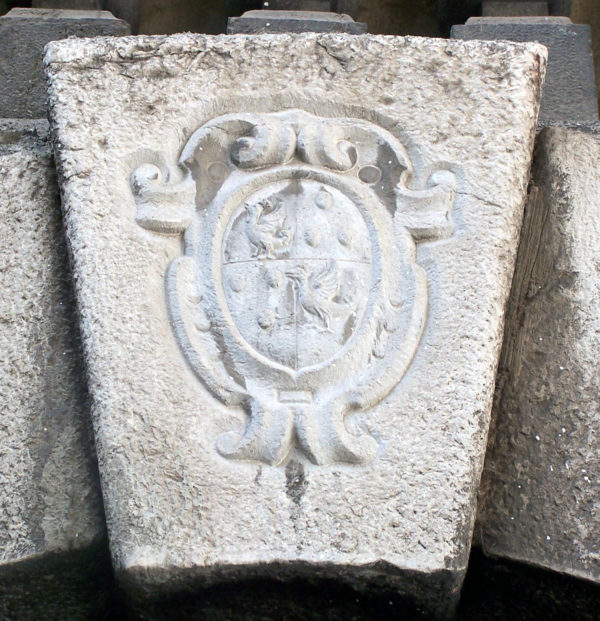
Coat of arms of the Wazenberg family in Ljubljana
LJUBLJANA, MESTNI TRG 10
Location of the coat of arms: portal
Above the exit from the atrium of the house at Mestni trg 10 in Ljubljana is still visible a relatively well preserved and discernible coat of arms with a somewhat comical figure reminiscent of a rooster flapping its wings. The coat of arms belonged to the now all-but-forgotten family of the Counts Wazenberg (initially Waz von Wazenberg), who owned the house for the entire seventeenth century and early decades of the eighteenth century. Bearing this in mind, the rooster may therefore also be identified as the dragon (which was painted golden yellow). In 1612, the house passed into the hands of Anna Waz, whose family’s coat of arms was probably carved in the atrium during the restoration of the building following the change in ownership.
The first Waz in Carniola, Vinzenz, was a native of Bergamo who moved to Ljubljana in the second half of the sixteenth century, where he forged a successful career as a cloth manufacturer and dealer. In Carniola, the original Italian form of his family name, Bazo, was Germanized to Waz or Wazen. In 1612, his widow Anna first purchased the house at Mestni trg 10 and later that same year also the Mirna seigniory with her sons Peter, Georg, and Michael. Ownership of this seigniory entitled the Waz brothers to be admitted to the Carniolan provincial estates at the end of January 1620.
Although Vinzenz’s sons tried to demonstrate that their father already had a noble rank, sources do not support their claim, and Emperor Ferdinand II confirmed their ennoblement no earlier than 1624. Nonetheless, they clearly used the coat of arms with the dragon before that, as is also attested by its depiction in stone at Mestni trg 10 and the wording in the diploma from 1624, which entailed its improvement. The document first made a reference to the coat of arms with a golden dragon and silver roundels, which the Wazes had “had from before,” and then to another, which they had inherited from their ancestors and used “since times immemorial.” The latter differed substantially from the former by being divided into blue and silver fields, each featuring a double lily in alternating colors. In 1624, the coat of arms “from times immemorial” was converted into a heart-shaped escutcheon and incorporated into that featuring the dragons. Regarding the coat of arms at Mestni trg 10, mention also ought to be made of its slight deviation from the “official,” imperially recognized and confirmed old coat of arms. The roundels in its third field are set in a 2:1 ratio, although the imperial variant in both (the second and third) fields stipulates the ratio of 1:2. The baronial and comital coats of arms also consistently arrange roundels in the ratio 1:2.
Over time, the family also came into possession of the seigniories of Svibno (Scharfenberg), Metlika (Möttling), Slatna (Slatenegg), and Dob (Aich). In 1650, Michael Waz von Wazenberg requested the title of baron, stressing in his petition that he had completely rebuilt Aich Mansion and asked that it be renamed Wazenberg. In 1673, the family was further elevated to the rank of counts, abandoned its original name Waz and replaced it with Wazenberg. The last Count von Wazenberg was Karl Heinrich, who spent the final years of his life in Gorizia (Germ. Görz), where he died in early 1730.
